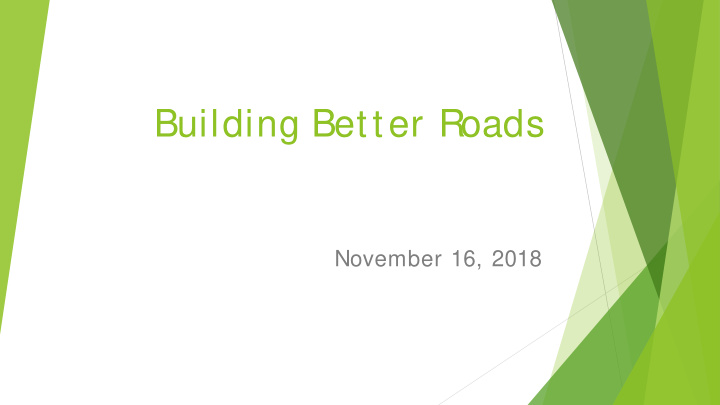



Building Better Roads November 16, 2018
San Diego County Aggregate S ustainability PCC grade aggregates are required for all construction proj ects whether it be road resurfacing, or new building construction S an Diego has been depleting its natural resources (aggregates) at a steady pace without permitting new sources Historical applications have taken up to 17 years to get permitted or have failed after a long expensive process S an Diego aggregate pricing is one of the highest in the state and we are in a situation that will get considerably worse in the next 10 years New mining operations are not popular and need to be measured on global impacts to the county instead of a district issue Increased fuel usage, traffic congestion, emissions, etc. Building Better Roads-November 2018
San Diego County PCC Aggregate Sustainability The California Department of Conservation has been collecting data and tracking aggregate reserves for about 40 years Only one state geographical area has less reserves(less than 10 years) than S an Diego County (S an Fernando Valley/ S augus-Newhall S an Diego has an estimated time frame of between 11 to 20 years or 265MM tons of permitted reserves out of a proj ected 50 year demand of 763MM tons It is estimated that over 30 % of the aggregate usage is currently imported PCC Aggregate is a relatively low unit cost- high volume product that should come from local sources Imports have significant risks such as source location changes, and transportation disruptions Building Better Roads-November 2018
California Geological Survey 2018 Map 52 Western San Diego Region Building Better Roads-November 2018
Building Better Roads-November 2018
San Diego County PCC Aggregate Sustainability (cont.) Reserve estimates are based on historical trends and proj ected population increases. There are valid factors which could accelerate depletion of reserves. Location in County Quality of aggregates for the intended use Risks of permit changes or imported material disruptions Demand increases (S B 1) Permitted reserves concerns Construction proj ect cycles likely will not balance to production capacity from aggregate processing facilities There is no guarantee that all permitted reserves can be mined Building Better Roads-November 2018
PCC Aggregate Sustainability What Can Be Done? Recycled Materials are a large cost saving opportunity for construction proj ects (j oint task force? ) S pecifications can be geared towards allowing the appropriate use of recycled materials Recycled aggregates are used in other geographical areas Use of natural aggregates for road base or other underground uses should be discouraged by specification Permitting of local sources is a problem that will have to be addressed by political processes and should be a priority Building Better Roads-November 2018
Recycled Asphalt Management Recycled asphalt (RAP) Asphalt grindings Only a small percentage of recyclable asphalt is used back into asphalt mix designs The balance of asphalt grindings are currently used in recycled base but at a limited percentage, and if practical uses are not found will have to go to landfills. Asphalt grindings also contain oil that should be conserved and reused Current County regulations limit the amount of inert storage capacity at recycling locations which does not always balance with actual construction proj ect cycles Percentages of RAP allowed in mixes is a small percentage of the asphalt mix design. Other agencies have successfully implemented RAP programs that work and can save on construction costs to agencies Building Better Roads-November 2018
County Board of Supervisors Diversion Goals Agenda item from April 26, 2017 Board meeting Building Better Roads-November 2018
County Board of Supervisors Diversion Goals (cont.) Agenda item from April 26, 2017 Board meeting Building Better Roads-November 2018
There is nothing in RAP that if handled Proper best practices properly reduces the can insure a high quality of the recycled quality finished asphalt mix design product performance. Recycled Asphalt Does it have a bad RAP? Building Better Roads-November 2018
San Diego County Trucking and Labor Concerns Imported Materials at the current estimated rate amounts to approximately 56,000 truckloads per year, 1,250,000 gallons of diesel(additional impact over local sources) Truck availability or lack of CARB impact to availability of actual units in 2019 Previous recessionary cycle removed many trucks from the market Driver shortage Limited construction windows require more trucks S tringent specifications can have a larger negative impact on labor shortages Building Better Roads-November 2018
Building B g Better Roads I Initiati tive • Resources- aggregates • http://www.calapa.net/ • http://www.calcima.org/ • http://www.distancematters.org/ • http://www.conservation.ca.gov/cgs/Documents/Publications/MS_052_California_Aggregates_Map_201807.pdf • http://www.conservation.ca.gov/cgs/Documents/Publications/MS_052_California_Aggregates_Report_201807.pdf • Resources- RAP • https://www.sandiegocounty.gov/dpw/recycling/cdhome.html Building Better Roads-November 2018
Recommend
More recommend